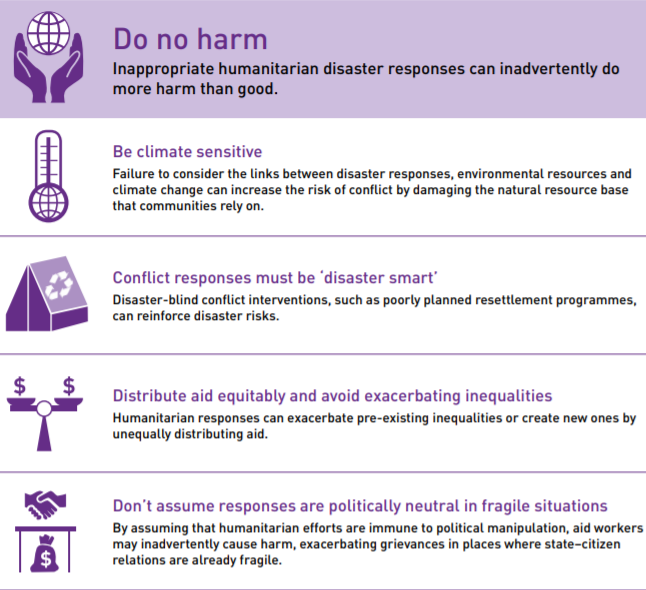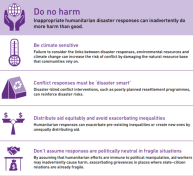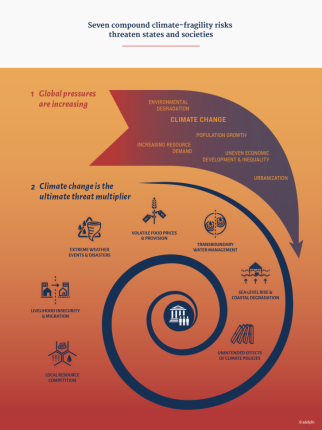-
Why Climate and Conflict Are Shaping the Crises of Our Time (And What To Do About It)
February 24, 2020 By Janani Vivekananda Humanitarian need is increasing. Crises are becoming more complex through the interactions between climate change, disasters, and conflicts. Not only are humanitarian crises on the rise, but the nature of crises is changing, largely due to climate change-driven extremes such as floods, droughts and typhoons. Over 90 percent of disasters are believed to be related to climate.
Humanitarian need is increasing. Crises are becoming more complex through the interactions between climate change, disasters, and conflicts. Not only are humanitarian crises on the rise, but the nature of crises is changing, largely due to climate change-driven extremes such as floods, droughts and typhoons. Over 90 percent of disasters are believed to be related to climate.
Humanitarian need is increasing. Crises are becoming more complex through the interactions between climate change, disasters, and conflicts. Not only are humanitarian crises on the rise, but the nature of crises is changing, largely due to climate change-driven extremes such as floods, droughts and typhoons. Over 90 percent of disasters are believed to be related to climate.
The future promises no respite. As climate change converges with other pressures—rapid population growth, widening inequality, un-planned urbanisation, changes in water and food availability, and political instability—the coming decades will see these pressures transmute into more frequent, intense, and protracted humanitarian crises.
More than 50 percent of people affected by disasters between 2005 and 2009 lived in fragile and conflict-affected areas and this figure is consistently rising. People living in countries in conflict are disproportionately vulnerable to climate risk. On the one hand, conflicts impact the effectiveness and access to the institutions, markets, and livelihoods people rely on to adapt to climate impacts. At the same time, climate shocks—like droughts or flooding—can have major consequences for communities struggling to cope with an armed conflict, further impoverishing them, leading to greater food insecurity and health problems, and forcing many to move for their survival. Working to strengthen the resilience of these communities and their institutions to climate and conflict risk is therefore critical.

So what can we do?
As the nature of risk has changed, so too should risk management and response mechanisms. This calls for a shift to ensure institutions are better able to address linked climate and fragility risks before they spiral into a crisis.
Do No Harm. Applying a conflict-sensitive and climate-sensitive approach to humanitarian responses minimizes harm and assists in managing both conflict risks and the risk of mal-adaptation.
Finance mechanisms that allow integrated responses. Humanitarian funding—although relatively high and growing—is insufficient to meet burgeoning demand. And the funding that is available needs to be deployed more effectively. This can be achieved through integrated financing by creating and prioritizing hybrid funding streams that are not strictly humanitarian or developmental; enabling more and better cross-sectoral work; providing flexible, accelerated, and risk-tolerant funding; and creating financing mechanisms that take account of different needs and timeframes particularly in protracted crises
Learn from each other to truly understand risk and build resilience. The inter-linked nature of risks requires enhancing capacities to undertake joint risk analysis. An important first step is improving the understanding and analysis of local contexts and the nature of risks. But risk analysis on its own is not enough. Capacities to translate this analysis into conflict- and climate-sensitive responses are equally important.
Reform humanitarian and peacebuilding institutions to be ‘fit for purpose’ to deal with climate-fragility risks. To be effective, governments, donors, and implementing agencies need to reform the silos created by institutional mandates and financial structures. They need to move beyond short-term, project-driven responses and put in place pragmatic incentives to work towards collective outcomes.
The good news is that, on paper at least, the global policy makers have recognized this challenge and have pledged a move toward a “new way of working” in protracted and repeated crises. The so-called “triple nexus”—the nexus between humanitarian, development and peace sits at the heart of UN reform and comes with a raft of principles and enabling structures. The proof of course lies in what the approach this means for affected persons. But for now at least the direction of travel is the right one.
Janani Vivekananda is a Senior Advisor on climate change, peace and security and a Senior Project Manager at adelphi.
Sources: Overseas Development Institute, United Nations Joint Steering Committee to Advance Humanitarian and Development Collaboration, United Nations Office for Disaster Risk Reduction
Photo Credit: A New Climate For Peace, adelphi 2015
 A Publication of the Stimson Center.
A Publication of the Stimson Center.

 Humanitarian need is increasing. Crises are becoming more complex through the interactions between climate change, disasters, and conflicts. Not only are humanitarian crises on the rise, but the nature of crises is changing, largely due to climate change-driven extremes such as floods, droughts and typhoons. Over
Humanitarian need is increasing. Crises are becoming more complex through the interactions between climate change, disasters, and conflicts. Not only are humanitarian crises on the rise, but the nature of crises is changing, largely due to climate change-driven extremes such as floods, droughts and typhoons. Over 






